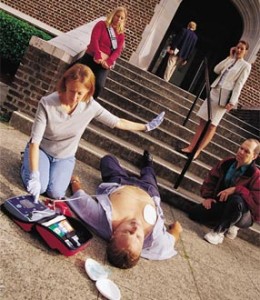
The whole world was devastated when the King of Pop, Michael Jackson, died of cardiac arrest several weeks before he was about to begin his comeback sold-out concert. He was 50 years old. Christopher Reeve, popularly known for his portrayal of superhero “Superman,” also died of cardiac arrest, after almost a decade of being paralyzed. He was 52 years old. “Clueless” star Brittany Murphy also passed away of cardiac arrest. She was only 32 years old. Lastly, Tracey Conway of “Almost Live,” when she was 38 years old, collapsed while taping on stage. Fortunately, unlike the previously mentioned stars, paramedics were able to revive her. Cardiac arrest can strike anyone, anywhere. It does not pick its victims. However, more often it chooses middle age people with no history of heart ailments.
Cardiac arrest, also called cardiopulmonary arrest or circulatory arrest, is when the heart stops beating. It occurs instantly. The heart has an intrinsic electrical system which controls the rhythm of the heartbeat. Arrhythmias, or abnormal heart rhythms, occur that cause the sudden cardiac arrest. However, cardiac arrest must not be mistaken for heart attack. Heart attack or myocardial infarction is when a portion of the heart muscle is starved from blood flow but there is still cardiac activity, whereas cardiac arrest is when there is loss of cardiac function, hence there is no cardiac activity. Therefore, it has a very high mortality rate. Cardiac arrests are characterized by a sudden collapse or loss of responsiveness and no normal breathing occurs when the head is tilted up (American Heart Association 2011).
Instructional Training on how to deal with heart issues
[media url=”http://www.youtube.com/watch?v=6nOz0V3Yhx0″ width=”600″ height=”400″]Once these are observed in a person, do not hesitate to call for emergency medical services. If there is an available automated external defibrillator, or AED for short, immediately use it. However, if one is not accessible at that moment, begin red cross CPR, which should be continued until the paramedics arrive.
According to Abella (2012), there are multiple factors to survival variability in a cardiac arrest: (1) public knowledge about CPR and willingness to perform (2) availability of AEDs and number (3) quality of emergency medical services (EMS). Although the community has no control over numbers two and three, it is capable of learning about performing CPR. CPR courses are offered in various institutions such as St Mark James, wherein, certification is offered to those who complete the program.
It is said that the sooner treatment is given, in this case CPR, the chances for restoring a regular heart rhythm are higher. Survivability is highest when action is done within the first few minutes. However, high quality CPR gives the chance for resuscitation. Moreover, Gallagher, et al (1995) on a study, which observed lay public CPR by arriving EMS professionals, observed that victims who received high quality CPR were four times more likely to be resuscitated.
Furthermore, AED is also an effective treatment to restoring heart rhythm. As previously mentioned, it can happen at any day to anyone. The mean response time for responders after calling for emergency response treatment, is 8-12 minutes. Every minute delay of defibrillation, there is a decreased 10% chance of survival, therefore, AEDs are should be located even in public places, as even a person with no medical background can use it (American St Mark James 2013). Find for a nearest first aid training locations near you and enroll.
[note color=”#60c4d9″]St Mark James First Aid References for this article:[/note]American Heart Association [Internet]. 2011. Symptoms & emergency treatment of cardiac arrest. Dallas: American Heart Association; [cited 2013 Jun 05]. Available from: http://www.heart.org/HEARTORG/Conditions/More/CardiacArrest/Symptoms-Emergency-Treatment-of-Cardiac-Arrest_UCM_307911_Article.jsp
American St Mark James [Internet]. 2013. Learn about automated external defibrillators. Washington: American St Mark James; [cited 2013 Jun 05]. Available from: http://www.redcross.org/prepare/location/workplace/easy-as-aed
Gallagher EJ, Lombardi G. Gennis P. 1995. “Effectiveness of bystander cardiopulmonary resuscitation and survival following out-of-hospital cardiac arrest. Journal of the American Medical Association. 274 (24): 1922-1925.
National Library of Medicine [Internet]. 2011. Cardiac arrest. Bethesda (MD): National Institutes of Health; [cited 2013 Jun 05]. Available from: http://www.nlm.nih.gov/medlineplus/cardiacarrest.html
